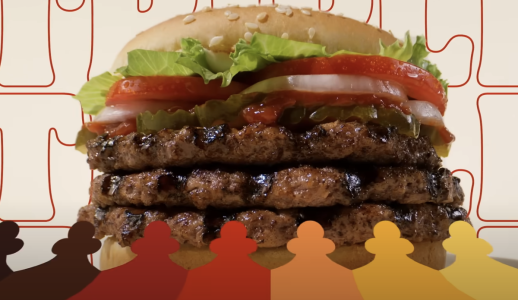Burger King in court—are fast food photos too good to be true?
By
Veronica E.
- Replies 0
Have you ever picked up a fast-food burger and felt let down when it didn’t quite match the mouthwatering picture on the menu?
Maybe the bun looked a little squished, the toppings weren’t as fresh, or the patty seemed smaller than you expected.
It’s a common experience—one that leaves many customers feeling like they didn’t get what they paid for.
You’re not alone—and now, that familiar disappointment is at the center of a legal battle.
A group of customers from across the country has come together to challenge what they see as misleading advertising in the fast food world.
Burger King, the second-largest burger chain in the US, is at the center of a class-action lawsuit involving 19 customers from 13 states.
The complaint? That the company’s ads show a much larger Whopper than what customers actually receive.
According to the lawsuit, marketing photos depict burgers with overflowing beef patties and toppings that appear to spill out of the bun—images that suggest a much heartier sandwich than what’s delivered in reality.
Some ads even make it look like the Whopper contains twice as much meat.
Burger King admits its burgers are styled to look their best in advertising, but the company argues this is common practice and that customers know what to expect.
They described the marketing as “puffery,” a legal term for harmless exaggeration used in sales.
But federal judge Roy Altman in Miami saw it differently.
He ruled that the case could move forward, stating that Burger King’s ads might “go beyond mere exaggeration or puffery.”
In other words, there’s a difference between making food look appealing and making it appear larger than it really is.
Burger King isn’t alone in facing criticism.
Similar lawsuits have been filed against McDonald’s and Wendy’s, although those cases were dismissed in New York.
What makes the Burger King case stand out is the extent of the alleged exaggeration in their marketing.
Subway is also dealing with a lawsuit over its steak and cheese subs.
The complaint claims their advertisements show generous portions of steak spilling out of the bread, while the actual sandwiches fall short. Subway has denied the claims.
For many shoppers—especially those on tight budgets or fixed incomes—getting what you pay for matters.
When a burger or sandwich doesn’t live up to its photo, it’s not just disappointing—it can feel dishonest.
Attorney Anthony Russo, who represents the Burger King customers, said it simply: “Consumers have the right to know what they are getting when they order food.”
Russo has filed similar lawsuits against major brands like Arby’s, Taco Bell, and Amazon, aiming to hold companies accountable through class-action cases.
It’s no secret that food shown in commercials or on menus gets special treatment.
Food stylists often use tricks—stacking extra toppings, fluffing buns, or even using inedible props—to make items appear more appealing.
The law does allow for some puffery.
But if the difference between the image and the actual product is too large, it could cross the line into false advertising—and that’s what the court is being asked to decide.
If the case moves forward and succeeds, Burger King and other chains may need to adjust how they advertise their food.
That could mean using more accurate photos, including clear disclaimers, or even changing how items are assembled in restaurants.
It could also set a new precedent for other industries where advertising often stretches reality.
Burger King, meanwhile, stands by its practices. “The flame-grilled beef patties portrayed in our advertising are the same patties used in the millions of burgers we serve to guests across the US,” the company said in a statement.
As this case unfolds, it’s a reminder that what we see in advertisements doesn’t always reflect reality—and that consumers have the right to ask questions and expect honesty.
Whether the lawsuit leads to changes in fast-food marketing or not, it highlights the growing demand for transparency in what we’re buying and eating.
After all, when it comes to something as simple as a burger, people just want to get what they were promised.
Read next: Exposed: The top fast food chains pumping your favorite meals with antibiotics - Is your favorite on the list?

Do you think fast-food ads are misleading, or is a little puffery just part of marketing? Have you ever felt disappointed by the difference between what you saw and what you got? Let us know in the comments—your voice matters, and it might help others make more informed choices!
Maybe the bun looked a little squished, the toppings weren’t as fresh, or the patty seemed smaller than you expected.
It’s a common experience—one that leaves many customers feeling like they didn’t get what they paid for.
You’re not alone—and now, that familiar disappointment is at the center of a legal battle.
A group of customers from across the country has come together to challenge what they see as misleading advertising in the fast food world.
A closer look at the Burger King case
Burger King, the second-largest burger chain in the US, is at the center of a class-action lawsuit involving 19 customers from 13 states.
The complaint? That the company’s ads show a much larger Whopper than what customers actually receive.
According to the lawsuit, marketing photos depict burgers with overflowing beef patties and toppings that appear to spill out of the bun—images that suggest a much heartier sandwich than what’s delivered in reality.
Some ads even make it look like the Whopper contains twice as much meat.
Also read: Is the new Steakhouse Whopper from Burger King worth trying? Here’s why it has everyone talking!
Exaggeration or misleading?
Burger King admits its burgers are styled to look their best in advertising, but the company argues this is common practice and that customers know what to expect.
They described the marketing as “puffery,” a legal term for harmless exaggeration used in sales.
But federal judge Roy Altman in Miami saw it differently.
He ruled that the case could move forward, stating that Burger King’s ads might “go beyond mere exaggeration or puffery.”
In other words, there’s a difference between making food look appealing and making it appear larger than it really is.
Also read: Battle of the Fried Chicken: How KFC's Lawsuit Against Church's Could Reveal the Truth About Your Favorite Recipe!
A trend in fast food lawsuits
Burger King isn’t alone in facing criticism.
Similar lawsuits have been filed against McDonald’s and Wendy’s, although those cases were dismissed in New York.
What makes the Burger King case stand out is the extent of the alleged exaggeration in their marketing.
Subway is also dealing with a lawsuit over its steak and cheese subs.
The complaint claims their advertisements show generous portions of steak spilling out of the bread, while the actual sandwiches fall short. Subway has denied the claims.
Also read: Arby’s makes a surprising legal vow to bring back this beloved menu item—find out what it is!
Why this matters to consumers
For many shoppers—especially those on tight budgets or fixed incomes—getting what you pay for matters.
When a burger or sandwich doesn’t live up to its photo, it’s not just disappointing—it can feel dishonest.
Attorney Anthony Russo, who represents the Burger King customers, said it simply: “Consumers have the right to know what they are getting when they order food.”
Russo has filed similar lawsuits against major brands like Arby’s, Taco Bell, and Amazon, aiming to hold companies accountable through class-action cases.
Also read: Subway’s new footlong will blow your mind—you won’t believe what’s inside!
Why food always looks better in ads
It’s no secret that food shown in commercials or on menus gets special treatment.
Food stylists often use tricks—stacking extra toppings, fluffing buns, or even using inedible props—to make items appear more appealing.
The law does allow for some puffery.
But if the difference between the image and the actual product is too large, it could cross the line into false advertising—and that’s what the court is being asked to decide.
Also read: America’s biggest sandwich chain is quietly disappearing—and fans are starting to notice
What could happen next
If the case moves forward and succeeds, Burger King and other chains may need to adjust how they advertise their food.
That could mean using more accurate photos, including clear disclaimers, or even changing how items are assembled in restaurants.
It could also set a new precedent for other industries where advertising often stretches reality.
Burger King, meanwhile, stands by its practices. “The flame-grilled beef patties portrayed in our advertising are the same patties used in the millions of burgers we serve to guests across the US,” the company said in a statement.
What you can do as a customer
- Share feedback: If a product doesn’t meet expectations, let the company know.
- Know your rights: Class-action lawsuits are one way consumers can speak up. If you see one you qualify for, you may be able to join.
- Tell your story: If you’ve had a fast-food order that didn’t match the ad, sharing your experience can help raise awareness.
As this case unfolds, it’s a reminder that what we see in advertisements doesn’t always reflect reality—and that consumers have the right to ask questions and expect honesty.
Whether the lawsuit leads to changes in fast-food marketing or not, it highlights the growing demand for transparency in what we’re buying and eating.
After all, when it comes to something as simple as a burger, people just want to get what they were promised.
Read next: Exposed: The top fast food chains pumping your favorite meals with antibiotics - Is your favorite on the list?
Key Takeaways
- Burger King is facing a class-action lawsuit from 19 customers in 13 states over claims that its Whopper advertisements exaggerate the size and ingredients of the burger.
- The judge ruled the case could move forward, saying the ads may go beyond acceptable “puffery” and potentially mislead customers.
- Similar lawsuits against McDonald’s and Wendy’s were dismissed, but Burger King’s case was seen as more extreme in its marketing claims.
- Subway is also under legal scrutiny for allegedly misleading steak sandwich ads, highlighting growing concerns about fast-food advertising across the US.
Do you think fast-food ads are misleading, or is a little puffery just part of marketing? Have you ever felt disappointed by the difference between what you saw and what you got? Let us know in the comments—your voice matters, and it might help others make more informed choices!







